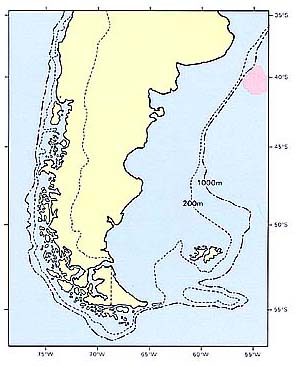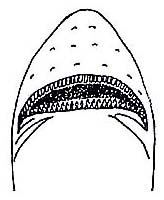ソコギス科
- HOME
- デジタル図鑑
- パタゴニア海域の重要水族
- 硬骨魚綱 ソコギス目 ソコギス科
ソコギス科(Notacanthidae)

3 クロソコギス(Kuro-sokogisu)
Notacanthus chemnitzi Bloch, 1788
特 徴:
背鰭8〜9棘,臀鰭14〜17棘,125〜145軟条,胸鰭15〜17軟条,腹鰭2棘,7軟条,側線鱗数114〜122,鰓条骨数9,鰓耙数3+13〜15=16〜18。頭長は体長の11.3〜12.5%,眼径は1.9〜2.3%,両眼間隔は3.1〜3.7%,吻長は3.4〜3.8%,上顎長は2.7〜3.3%,体高は9.2〜13.5%。体は延長側扁し,徐々に伸長する尾鰭を有する。頭部も側扁し,吻は円鈍。眼は中庸。両眼間隔域はやや狭く,隆起する。口は小さくて下位。上顎に1列,下顎に2列の鋭い小歯がある。左右両側の口蓋骨歯は前方で合し,数列の内側に湾曲した小歯からなる歯帯を形成し,その中側のものはやや大きい。眼の直前に位置する両鼻孔は相接近するが,無鱗の皮膚で隔てられる。鰓蓋弁はよく発達して丸く後方に伸びる。左右の鰓条膜は合して峡部から離れる。背鰭は8〜9棘よりなり,軟条は有しない。背鰭起部は胸鰭起部よりほんのわずかに後方に位置する。腹鰭は腹位で2棘を有し,軟条部は左右のものが連続する。胸鰭は小さい。臀鰭前部は短い棘からなり,中央部よりやや前方でより長い軟条におき変る。臀鰭後半部は尾鰭と連続する。尾鰭は徐々に伸長し糸状になる。頭部と体の全域は小円鱗でおおわれる。側線は背鰭に沿ってゆるやかに斜走するが,尾鰭後端までは達しない。肛門は臀鰭起部直前に開く。体は暗褐色で,鰓蓋と各鰭の縁辺は黒味を帯びる。
分 布:
熱帯域を除く世界全域(McDowell, 1973)。今回の調査ではアルゼンチン パタゴニア海域のみで漁獲された。
備 考:
我々の標本は矢部(1983)によるN. chemnitziの記載とわずかに違うところもあるが,それらは種内変異と見なす。水深約130〜3,230mから知られている(矢部,1983)。
(中村 泉)
Material examined:
5 from Argentina (590.0-734.0 mm TL, 577.0-720.0 mm SL), FSFLEL 903; EM 202, 265, 321, 313.
Description:
D Ⅷ-Ⅸ A ⅩⅣ-ⅩⅦ, 125-145; P1 15-17; P2Ⅱ, 7; LLS 114-122; BR 9; GR 3+13-15=16-18.HL 11.3-12.5% of SL; ED 1.9-2.3; BD 9.2-13.5; SN 3.4-3.8; IO 3.1-3.7; UJ 2.7-3.3; BD 9.2-13.5.
Body elongate and compressed with tapering tail. Head compressed with round snout. Eye moderate in size. Interorbital region fairly narrow and convex. Mouth small and inferior. Teeth in a row on upper jaw, in two rows on lower jaw. Two nostrils just in front of eye, closely situated each other but separated narrowly by smooth and scaleless skin. Palatine tooth patches meeting on midline, each with 2 to 4 irregular rows of slender inwardly curved teeth, medial ones longest. Opercular flap well developed, projecting backwark roundly. Right and left branchiostegal membranes united each other and free from isthmus. Dorsal fin composed of 8 or 9 spines only, its origin slightly posterior to pelvic fin origin. Head and body covered with fine cycloid scales. Lateral line single, running nearer to dorsal profile with gradual curve anteriorly.
Distribution:
Worldwide except tropical waters.
Remarks:
Our specimens show slight difference in several characters from N. chemnitzi reported by Yabe (1983). Besides two species described here, N. spinosus Garman, 1899 from the Pacific coast of northern South America, N. indicus Lloyd, 1909 from the Arabian Sea, N. abotti Fowler, 1934 from Philippines and southern Japan, and N. bonapartei Risso, 1840 from the Mediterranean and East Atlantic have been known so far (McDowell, 1973). Fully mature specimens differ from all other notacanths in large size, with a gnathoproctal length (the straight line distance from the tip of the lower jaw to the anal opening) in excess of 200 mm and reaching at least 443 mm (McDowell, 1973).
(Izumi NAKAMURA)

Distribution of Notacanthus chemnitzi in Patagonia.

Ventral view of mouth.
- 1
- 2